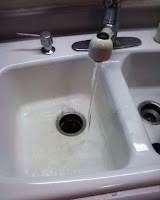
First we need to find out if the garbage disposal is deffective. Turn on the switch and listen. If you have no sound at all, make sure your garbage disposal is plugged in correctly. If there is a sound (like a humming sound) but the actual teeth/blades aren't moving, then what you want to do is manually turn the blades. Sometimes water can turn to rust and bind the blades from moving. This is what can cause the humming sound. How to do this? Unplug your garbage disposal. Get an allen wrench key and go to the bottom of the garbage disposal and there will be an allen wrench socket for that key to go into. Turn either counter clockwise or clockwise. Doesn't matter. You might have to use a little pressure. If it turns freely, plug everything back in and turn it on. If you still have no sound, check the reset button that's next to the allen wrench key. If still nothing, you probably have a deffective garbage disposal. So let's replace it.

Unplug the deffective garbage disposal. By the way, I see a problem here. They were using a regular household plug for the garbage disposal. That's a no no. They should have a GFI outlet that the garbage disposal plugs into. So if you have this situation and you're within 4 ft of a wet area you should really have a GFI outlet that your disposal plugs into. (A GFI outlet is one that has the red and black buttons. One will say test and the other says reset)

 Now with no power going to the garbage disposal we need to unhook all of the hoses and traps from the garbarge disposal.
Now with no power going to the garbage disposal we need to unhook all of the hoses and traps from the garbarge disposal.
Take the allen key and put it in the hole at the top of the garbage disposal indicated in the two pictures above. Turn clockwise until it turns off. You should only have to turn a half of turn and it should drop out of the sink. Be careful, there could still be some chunks of food or water in it so keep it upright.

Now with the garbage disposal out of the sink, it's time to put the new garbage disposal in. You can also replace the silver ring that's attached to the actual sink. But in this case it's still good and there's no reason to replace it.
If you have a dishwasher you're going to have to pop this piece out that's blocking the dishwasher drain. Your dishwasher hose drain is going to connect to this one inch drainhole from the garbage disposal. (very important to remove this piece otherwise it will be VERY MESSY when you put a load of dishes into your dishwasher. hahaha)
A common mistake that a lot of people make (even me) is when they unscrew the electrical plate to hook up their new pigtail plug they hook it up in the box itself (as seen in the second picture). But now you can't put the cover back on with the cord of the pigtail sticking out of the box. The right way to do it is...
This is the right way. First get a connector (picture 1). It may not come with it. Screw it into the hole next to the wire panel as seen in picture 2. Then install your pigtail through the connector and out of the box. Connect black and black, white and white and screw the ground (which is the green) to the green screw as seen in picture 3.
Now with everything wired and ready to go we're going to hook up the new garbage disposal to the sink. We're going to get our trusty allen wrench and slide it in the hole of the mounting bracket. While holding the bottom of the garbage disposal firmly to the sink you need to turn it a half turn. It should tighten right on as seen in picture 1. Then hook up the trap. IMPORTANT: make sure to use a new gasket when hooking up the trap. The garbage disposal should come with one. If you have a dishwasher, don't foret your dishwasher drain line. And we're done!
Now that we've got it plugged in, turn the water on, making sure it's on the garbage disposal side of the sink and turn the garbage disposal on. Let it run for about 15-30 seconds as you're looking underneath the sink for leaks. If everything looks and sounds good...then you're good! Way to make it happen with Ron!

























































